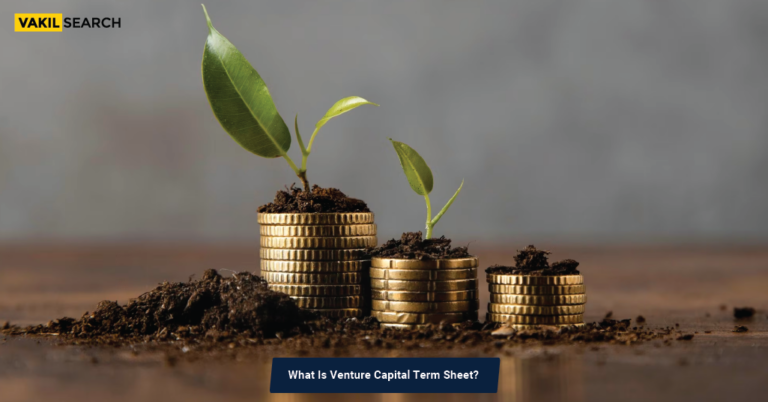What is the meaning of 'ratchet' on a VC term sheet? Vakilsearch is here to answer your question, read to know more about the same
Ratchet Meant VC Term Sheet: When you think of VCs, the first thing that probably comes to mind is a shark-jawed fund manager with a black leather briefcase. But for many start-ups, a trip to the capital market doesn’t mean much more than that. That’s far from the truth. Venture capital is a community effort, and many different people can be called ‘residents’ rather than ‘vippsters’ in this world. This article explains what a ratchet is and what it means on a venture capital term sheet and other terms you should know about raising capital from venture capitalists.
What Is a VC Term Sheet?
Term sheets outline the financials of an investment. It’s the first meeting between an investment bank and a potential investor. In this meeting, the bank will give the company an assessment of its financial health. The bank’s job is to get as much info as possible to make sure the company is financially sound and viable. A term sheet can outline the financial aspects of an investment. Still, it can also include non-financial conditions like restrictions on the company’s operations and its management.
You can get a term sheet drafted quickly and hassle-free by contacting Vakilsearch. Just check out the link and contact us today. (Click here)
What Is a Ratchet?
In private equity, a ratchet is a mechanism used to change the amount of equity held by founders, managers, and employees post-investment. Ratchets function as anti-dilution provisions in venture capital. By keeping entry prices low, they protect early-stage investors from dilution.
The ratchet clause stipulates that if another VC pays a lower price for a share of your start-up, the VC that originally bought the shares is entitled to a price adjustment. It doesn’t seem so problematic at first glance. Depending on the stage, however, the impact may vary.
When investors sign a term sheet, they commit to a level of funding that may not be enough to take the company to its full potential. Companies will often attach ‘ratchets’ to the financing agreement to address this. Ratchets are milestones or times when the investor is expected to provide additional funding. There are many situations where a company might want to attach a ‘ratchet’ to its term sheet to get the required amount of cash.
How Does a Ratchet Work?
Ratchets protect early investors by not letting future fundraising rounds dwindle their stake. Also, this provision provides cost protection if the price in future rounds is lower than the first. There are some caveats, though. This can be quite costly for company founders or investors participating in later fundraising rounds.
A ratchet provision can make it hard for a company to get new funding. Due to this, ratchet provisions are usually only in place for a limited time.
Ratchet Example
Consider this example: a company sells 1 million convertible preferred shares at a price of $1.00 per share. The terms of the deal include the use of a ratcheting mechanism. Consider the case where after the second round of fundraising, the company sells one million common shares at a price of $0.50 per share.
According to the ratchet provision, the company would be required to reduce the conversion price of preferred shareholders’ shares to $0.50 to compensate them. To ensure that their ownership is not diminished by the sale of the newly issued common shares, preferred shareholders would need to be given new shares (at no additional cost).
As a result of the dynamic above, new shares can be issued to satisfy both the demands of the original preferred shareholders (who enjoy the full ratchet provision) and the needs of new investors who wish to purchase a fixed percentage. A substantial percentage of ownership is what investors want, not just a number of shares.
As a result, company founders can find their ownership stakes rapidly diminished by the constant back and forth between old and new investors.
How Is It a Ratchet Calculated
Calculations are always made using a common stock basis
| NCP’ OCP * ((CSO + CSP) / (CSO + CSAP)) |
|
NCP = The new conversion price OCP = The old conversion price CSO = A common stock outstanding CSP = Common Stock that can be purchased with consideration (that is ‘what the buyer should have bought if it hadn’t been a ‘down round’ issuance’) CSAP = Common stock actually purchased upon subsequent issuance (that is, ‘what the buyer actually purchased’) |
What Do Ratchets Mean on a VC Term Sheet?
When investors sign a term sheet, they commit to a level of funding that may not be enough to take the company to its full potential. Companies will often attach ‘ratchets’ to the financing agreement to address this. Ratchets are milestones or times when the investor is expected to provide additional funding. There are many situations where a company might want to attach a ‘ratchet’ to its term sheet to get the required amount of cash.
Why Do VCs Use Ratchets?
The advantages of a ratchet include enhanced efficiency, reduced risk of mistakes, and automation. Every action is linked to one or more subsequent ones in a ratchet. This is especially useful for smaller companies, which may not have the funds or connections to operate a dedicated VC fund. This is not to say that a general investment fund has to use a ratchet. A seed fund can often act on its own with limited support from a fund manager. Suppose you are interested in using a dedicated fund. In that case, you should take a look at a firm with a more extensive history in the industry.
Conclusion
It does not matter how well you have conducted your due diligence, and you never know who you will attract as an investor. Your objective is to create a profile that best suits the investment climate in your particular region or industry. The key is to understand your specific industry and be aware of your competitors’ funding strategies. After selecting an investor and a funding opportunity, you can begin fundraising. Once you choose an investor and a funding opportunity, your team needs to work hard to impress the investor. You’ll have the funding you need to take your company to the next level in just a few short months.
If you find all this jargon confusing, you can now get in touch with a lawyer and even a company secretary. Click consult an expert at Vakilsearch, and we’ll handle it.
Read also:











